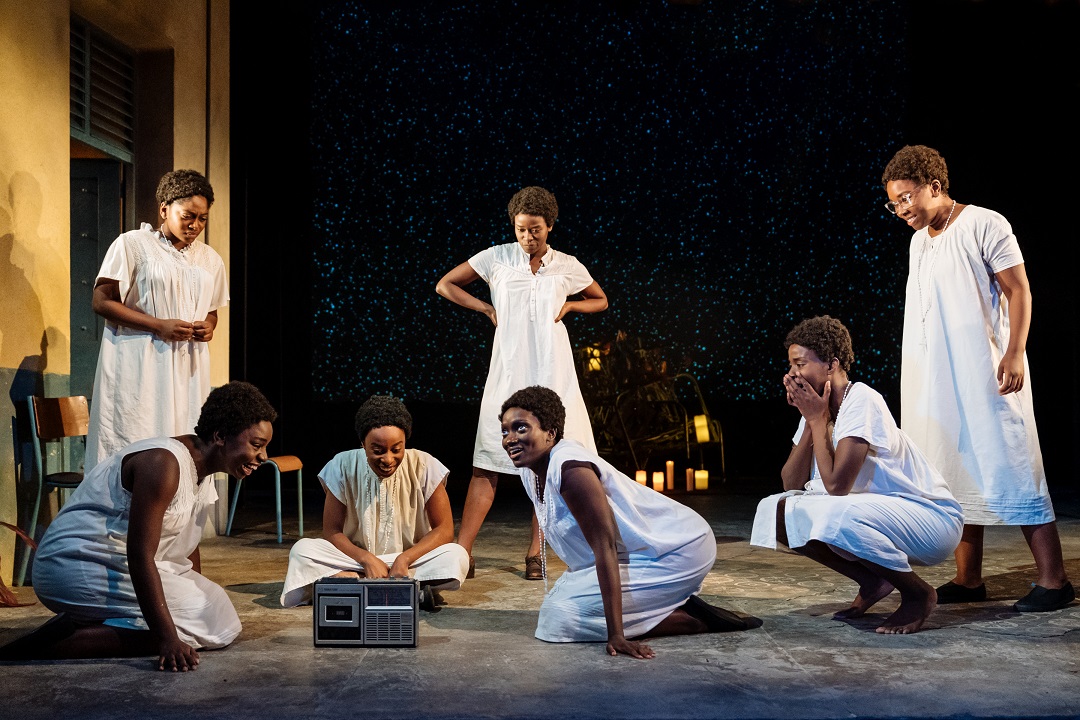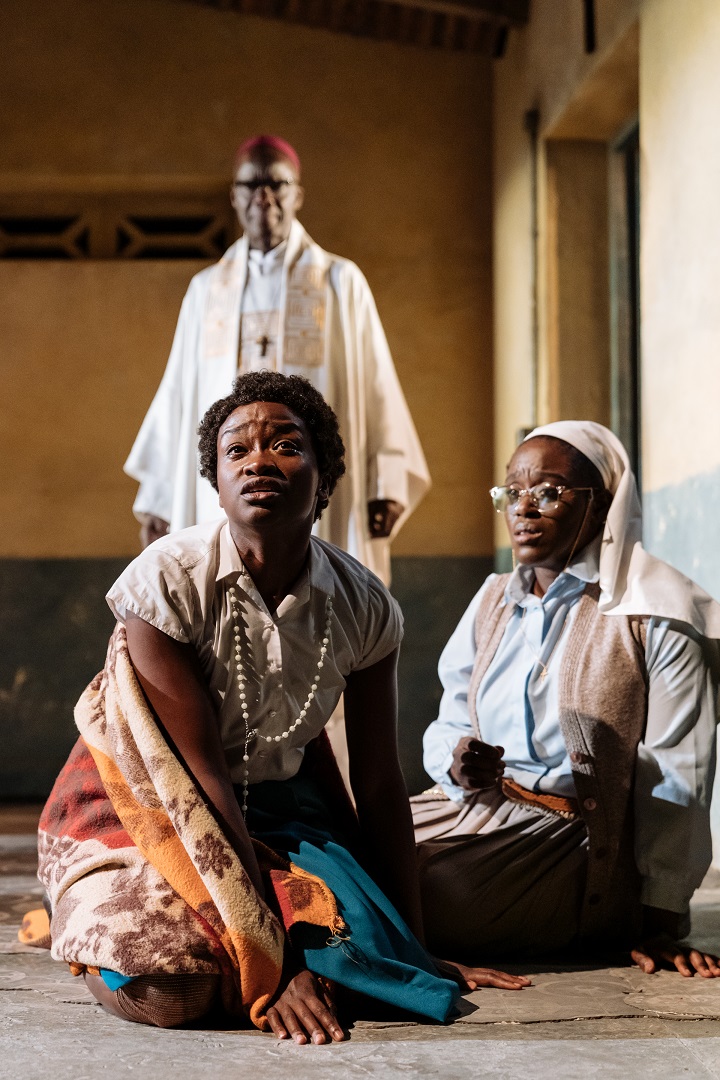The American dramatist Katori Hall has created a work of rare accomplishment in Our Lady of Kibeho, a play that combines a beautifully established picture of a particular world – a church school in rural Rwanda, in the early 1980s – with profound themes such as faith and belief.
That she brings her story, one that indirectly references the genocide that the country would experience a decade later, together with some choice character comedy is further testimony to her skill in combining the sacred and the secular. Premiered in New York in 2014, it reaches Theatre Royal Stratford East in James Dacre’s production first seen earlier this year at Northampton’s Royal & Derngate, with some cast changes. Dacre himself continues his cooperation with the playwright, having staged her previous work, the Martin Luther King-themed The Mountaintop, for which Hall won the Olivier Award for Best New Play in 2010.
Kibeho was where, in 1981, pupils at the local Catholic girls’ college began to report visions of the Virgin Mary, and it’s those circumstances that provide the broad outline for Hall’s story. At first it’s only one girl, Alphonsine (Taz Munya), who is disciplined for causing disturbance, but when two more pupils, Anathalie (Liyah Summers, like Munya new in the role at Stratford) and Marie-Claire (Pepter Lunkuse), start to share the experience, local interest grows, reaching first the local Church authorities and eventually going as high as the Vatican, which sends a priest to investigate. The content of the visions changes too, from initial ecstatic joy at divine revelation to far darker warnings delivered to a society that is, we come to understand, fraught with ethnic tension between its Tutu and Hutsi elements.
Hall charts the path from the opening innocence of her play to its closing drama beautifully, with considerable support from composer Orlando Gough and sound designer Claire Windsor: their soundscape, whether alternating between church refrains and African song or embroidering proceedings with rich birdsong, is key as accompaniment. It creates a vivid picture of this village world, where the everyday business of the school revolves around the contrasting approaches of its easy-going head, Father Tuyishime (Ery Nzaramba), and his much stricter deputy Sister Evangelique (Michelle Asante, a gem of a performance), as well as the group dynamics that bubbles between the girls (the entire company of seven girls, pictured below, interacts beautifully). At first these fits of possession are treated as schoolgirl pranks, a kind of attention-seeking, while the moments of ecstasy, as the spirit take over the girls’ trembling bodies and wide smiles beam across their faces, are benign. “She wants us to play,” Alphonsine recounts one encounter with the Virgin, who introduces herself as “Mother of the Word”, telling how she is struck by the apparition’s unearthly beauty, neither black nor white. It’s when the feisty, more pragmatic Marie-Claire becomes caught up in them too that the phenomenon begin to be treated differently, prompting the wary Sister Evangelique to report them to the local bishop (Leo Wringer), who is presented as a down-to-earth, broadly humorous character rather than anything more severe.
At first these fits of possession are treated as schoolgirl pranks, a kind of attention-seeking, while the moments of ecstasy, as the spirit take over the girls’ trembling bodies and wide smiles beam across their faces, are benign. “She wants us to play,” Alphonsine recounts one encounter with the Virgin, who introduces herself as “Mother of the Word”, telling how she is struck by the apparition’s unearthly beauty, neither black nor white. It’s when the feisty, more pragmatic Marie-Claire becomes caught up in them too that the phenomenon begin to be treated differently, prompting the wary Sister Evangelique to report them to the local bishop (Leo Wringer), who is presented as a down-to-earth, broadly humorous character rather than anything more severe.
As word spreads, as the “rustle in the valley” becomes a “roar”, local reaction initially centres on anxiety about it being manifestations of witchcraft, felt both by parents and in the form of a boy-man character, Emmanuel (Mitchell Zhangazha), whom Hall uses as a kind of chorus to communicate popular feeling. The second-half arrival of the “Vatican man” Father Flavia (Michael Mears) cause its own ruckus, not least because he’s the first white man the girls have encountered; as he follows his established process of documenting what is taking place, the prospect of the “validation” of what is happening raises a more secular realisation among some that this could be a miracle to be “commodified”, one that offers the potential to change a backwater neighbourhood into a centre of pilgrimage. (Pictured below, Pepter Lunkuse, Michelle Asante)
 There’s gentle comedy in how the characters’ perspectives gradually broaden as they interact more closely in these new circumstances. Hall doesn’t offer us any answers, leaving space for both scepticism and belief, though the play’s emotional core acknowledges that something remarkable is going on: it’s there, in the subtlest form, in the gentle insight that one girl sheds on Father Tuyishime’s secret predicament of his beleaguered faith as much as in the ability of another to engage with Father Flavia in terms, and another language, that go far beyond her own humble circumstances.
There’s gentle comedy in how the characters’ perspectives gradually broaden as they interact more closely in these new circumstances. Hall doesn’t offer us any answers, leaving space for both scepticism and belief, though the play’s emotional core acknowledges that something remarkable is going on: it’s there, in the subtlest form, in the gentle insight that one girl sheds on Father Tuyishime’s secret predicament of his beleaguered faith as much as in the ability of another to engage with Father Flavia in terms, and another language, that go far beyond her own humble circumstances.
Then, after the scenes of closing alarm, Hall skilfully seems to return her world to the uneventful rhythms of passing life that it had known before. Except that we sense, beneath the surface, that a terrible fate will shortly come to this land: it’s there in allusions in the play to other such miracles (like the one in 1917 at Fatima in Portugal), as well as the dramatic associations that inevitably come to us from the likes of Arthur Miller’s The Crucible, with its idea of possession as a reflection of a society’s subconscious unease. (The Ursuline possessions at Loudon that inspired Ken Russell’s The Devils might be another frame of comparison, although the context here is so much less obviously dramatic.)
The playing is luminous across the board, and the play revels in its sense of the patterning of life, how dramatic religious moments give way to the timeless world of a cappella singing, where the yellows and greens of designer Jonathan Fensom’s palette shade back and forth between the close-ups of his schoolhouse set and the sublimely beautiful African landscapes of the backdrop (that effect achieved no less by Charles Balfour’s lighting). There’s a somehow understated subtlety here that perhaps makes it hard to pinpoint Hall’s considerable achievement, its lasting effect being one that, like the visitations themselves, somehow lingers in the air like a scent, and Dacre’s achievement is to have given that nimbus the requisite form, endowing it with the sensitivity that it demands. We are left to decide for ourselves whether the Virgin spoke to the girls at Kibeho; what is in no doubt is that Hall’s play speaks to us.
- Our Lady of Kibeho at Theatre Royal Stratford East to November 2
- Read more theatre reviews on theartsdesk














Add comment